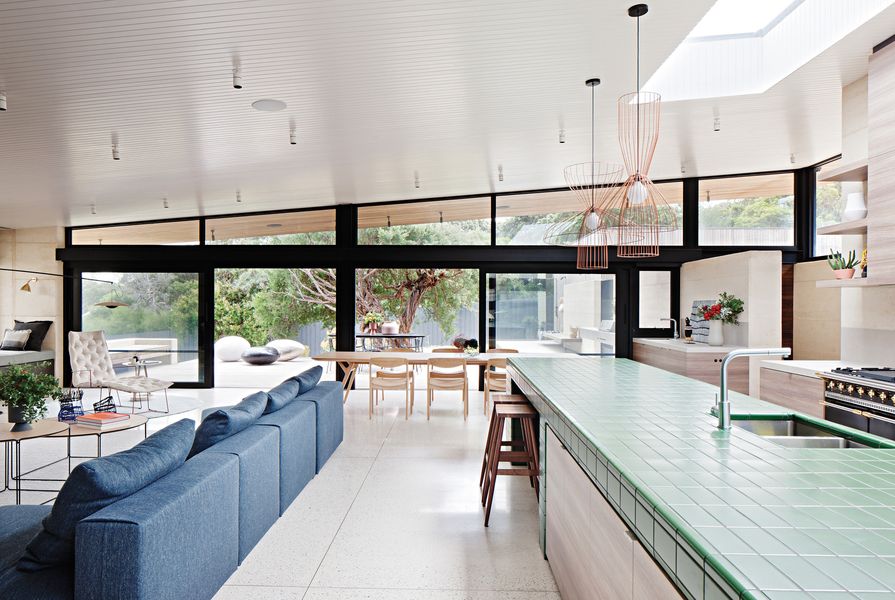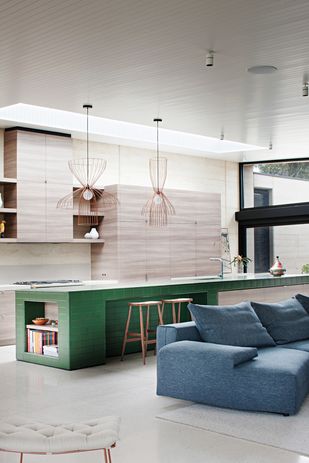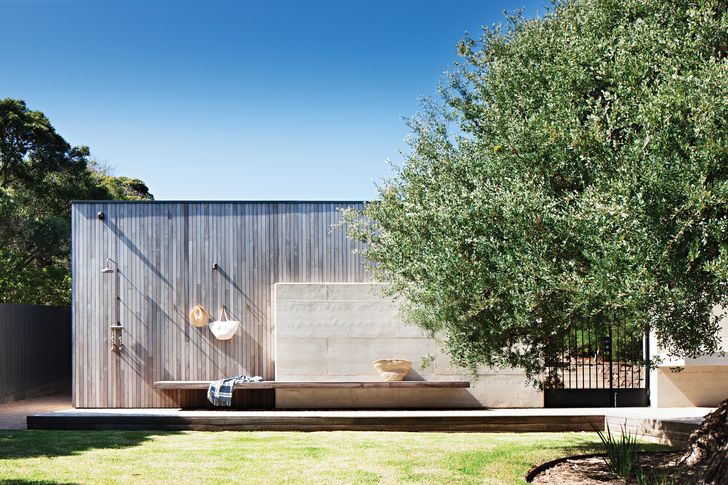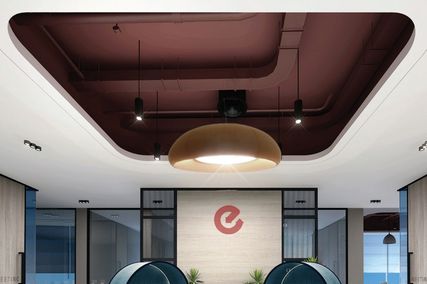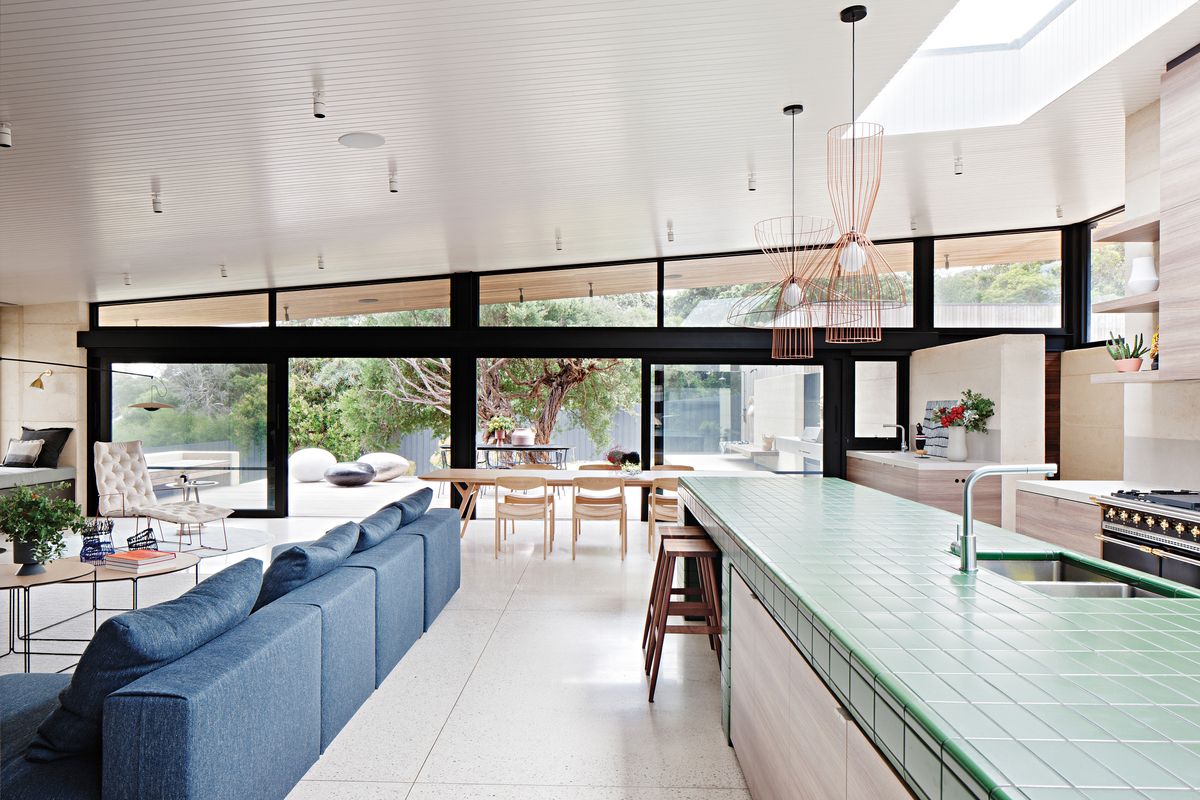When speaking of sustainability in architecture it’s only natural that our minds go to thermal mass, photovoltaics, recycled timber and brick, rainwater harvesting and the like – the material choices that reduce the environmental impact of constructing and occupying a building. But an aspect of sustainable design that is often overlooked is flexibility. The more adaptable a building is to different modes of use, the longer it’s going to be useful and the less likely it is to need renovation, or to be levelled and replaced. When architecture and interior design practice Robson Rak was approached to design a family beach house for a site on Victoria’s Bellarine Peninsula, this kind of sustainability was a key aspect of the client brief, for the house is intended to stay in the family not just for a few years, but for generations.
A pale, neutral material palette heightens the house’s connection to the landscape.
Image: Shannon McGrath
Exploration of the site revealed a subterranean network of limestone shelves and caves. Those layers of rock demanded a specific engineering solution, achieved in close collaboration with local builder Heyward Constructions, but in the minds of architects Kathryn Robson and Chris Rak the rock became a kind of geological metaphor for the layers of family that would occupy the house. During the design process, this came to be expressed in the layering of internal and external spaces. To accommodate extended family, the house had to be quite large and an overall form was created that sits naturally in the landscape, with the mass of the house broken up into separate yet connected modules.
As Chris describes it, the building “is quiet and understated from the street, and unveils itself as you walk through.” Visitors are drawn forward through a small courtyard that is partially enclosed by overlapping rammed-earth walls on one side and the garage on the other. With each step, more garden is revealed, and glimpses of trees over the walls and through the layers of the house encourage a sense of journey and discovery. Inside the entry door, a hallway peels away to the left, through a small study to a bedroom and ensuite; to the right, the space opens up into a lounge/dining/kitchen volume, which leads out onto two timber-decked terraces (a small, enclosed deck to the east and a larger deck built around and underneath a mature tea-tree to the west).
Beyond the living space, another hallway leads past two more bedrooms to an intimate library furnished with a single armchair and ottoman. A rewarding destination in itself, particularly for those wanting to hide away with a good book, it offers still more incentive for exploration, for a white staircase spirals down and out of view. Thanks to the sloping topography there was room at the back corner of the site for a lower ground floor, comprising a large playroom at the bottom of the spiral stairs, a fourth bedroom and a bathroom. It’s called a playroom because that’s what fits with the current family structure – and there’s a table tennis table in there! – but down the track, this space could be used for almost anything.
The sloping topography of the site allowed for a lower ground floor that includes a large playroom at the bottom of the spiral stairs.
Image: Shannon McGrath
The playroom enjoys beautiful views into the growing native garden at the rear of the house, and in this it is not alone. Without any beach views from the site, the architects created an aspect for every room in the house – small courtyards, the two terraces, restrained sculptural plantings and bushier garden zones. This connection to the outdoors is heightened by a neutral colour and materials palette that extends throughout the interior and exterior spaces. Pale rammed earth is the primary element, complemented by timbers, including similarly pale timber-veneer joinery and external cladding that will silver with age, and concrete floors. The neutral palette is disrupted briefly as a way of defining the kitchen zone within the open-plan living space, but even then it is with green tiles applied to the island bench, which references the foliage outside.
Pale rammed earth is the primary building element, complemented by timbers.
Image: Shannon McGrath
And that splash of green brings us back to the sustainability at the heart of this house. The material aspects of sustainable design are in full effect – there are thermally broken double-glazed window units, a tilted roof that protects the interior from the western sun and draws in direct sunlight to harness the thermal mass of the rammed-earth walls and concrete floors, louvres to promote cross-ventilation and much more – but so is that notion of adaptable occupation. The orientation and spacing of the four bedrooms, the room currently labelled “playroom,” the secluded outdoor spaces and twin terraces, mean that the house can be configured and co-inhabited in myriad ways.
You can imagine the place a few years from now, with the playroom transformed into a moody teenagers’ retreat. And, say, thirty years down the track, with the table tennis table dragged out again and dusted off, grandkids chasing balls around the room. The trees are fully grown, the rammed-earth walls still stand and have aged beautifully, and so has the silvery timber, and over the family is the invisible patina of a lifetime of memories.
Products and materials
- Roofing
- Lysaght Klip-Lok in Colorbond ‘Monument’.
- External walls
- Rammed earth by Earth Structures Surf Coast; Woodform Architectural burnt ash timber.
- Internal walls
- Rammed earth by Earth Structures Surf Coast; CSR plasterboard.
- Windows
- Architectural Window Systems Thermal Heart windows; Viridian double glazing.
- Doors
- Door hardware from Bellevue Architectural.
- Flooring
- Concrete; Hakwood Harmony engineered flooring.
- Lighting
- Yori Spotlights from Euroluce; Ligne Roset Parachute suspension light from Domo; Bestlite BL7 wall lamp from Cult; Gardens at Night Accent 8 external wall light.
- Kitchen
- Lacanche oven; Miele integrated fridge; Astra Walker sink mixer in ‘Brushed Chrome’; Navurban veneer; Maximum Venus porcelain benchtop from Artedomus; De Fazio Tiles and Stone island benchtop tiles in ‘Deep Green’.
- Bathroom
- Maximum Venus benchtops from Artedomus; Earp Bros Rhin Ivory wall tiles; Urban Edge Tex wall tiles; Rogerseller Tonic tapware and Mero showers.
- Heating and cooling
- In-slab hydronic heating; Cheminees Philippe fireplace; Surfcoast Heating and Cooling ducted airconditioning.
- External elements
- Eco Outdoor Ravello Travertine paving.
Credits
- Project
- Layer House
- Architect
- Robson Rak Architects
St Kilda South, Melbourne, Vic, Australia
- Project Team
- Kathryn Robson, Chris Rak, Rosie Giles, Jeremy Bishop
- Consultants
-
Engineer
Meyer Consulting
Landscape architect Heyward Constructions
Landscaping Digby Moran Garden Design, Mia Cooke Landscapes
- Site Details
-
Site type
Coastal
Site area 1300 m2
Building area 480 m2
- Project Details
-
Status
Built
Design, documentation 12 months
Construction 14 months
Category Residential
Type New houses
Source
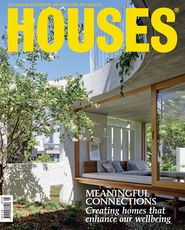
Project
Published online: 29 Jan 2018
Words:
Mark Scruby
Images:
Shannon McGrath
Issue
Houses, October 2017

